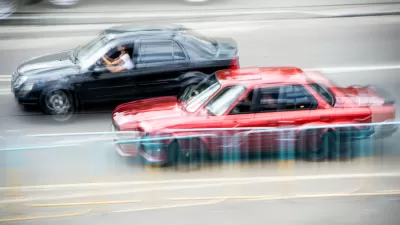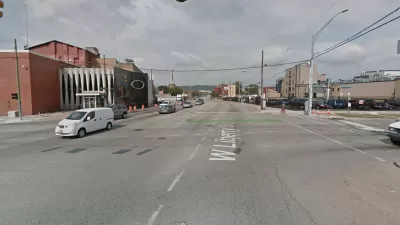With Vision Zero faltering around the country, maybe it's time to get back to the fundamentals of street design. An example from Cincinnati shows how street improvements can achieve significant improvements with relatively little expense.

"Cincinnati's Department of Transportation & Engineering will be installing speed cushions throughout the city after their temporary use in Winton Hills significantly dropped speeds for traveling vehicles," reports Allison Babka for CityBeat.
The rubber cushions, "which look like two speed humps side by side," helped reduce average automobile speed from 37 mph to 20 mph since they were installed on Winneste Avenue in Winston Hills, according to a February 7 report detailing the effects of the pilot project.
Just 11% of vehicles exceeded the posted speed limit of 25mph after installation. Before that, 95% did," writes Babka for additional insight into the results of the experiment.
The pilot project and the report are the result of the city's Vision Zero initiative. In another recent Vision Zero pilot project, the city's Department of Transportation & Engineering in December began testing plastic curb extensions at the intersection of Hamilton Avenue and Pullan Avenue in Northside. "The curb extensions prevent motorists from passing in the parking lane, and force traffic into one travel lane, slowing speeds into the pedestrian-friendly neighborhood business district," according to the city's website.
As reported by Babka, the city of Cincinnati claims to have implemented 200 pedestrian safety projects in 37 neighborhoods in 2021. In 2022, the city has budgeted $1.25 million for more pedestrian safety improvements.
FULL STORY: Cincinnati to Add More Speed-Reduction Cushions After Successful Pilot Program

Trump Administration Could Effectively End Housing Voucher Program
Federal officials are eyeing major cuts to the Section 8 program that helps millions of low-income households pay rent.

Planetizen Federal Action Tracker
A weekly monitor of how Trump’s orders and actions are impacting planners and planning in America.

Ken Jennings Launches Transit Web Series
The Jeopardy champ wants you to ride public transit.

Rebuilding Smarter: How LA County Is Guiding Fire-Ravaged Communities Toward Resilience
Los Angeles County is leading a coordinated effort to help fire-impacted communities rebuild with resilience by providing recovery resources, promoting fire-wise design, and aligning reconstruction with broader sustainability and climate goals.

When Borders Blur: Regional Collaboration in Action
As regional challenges outgrow city boundaries, “When Borders Blur” explores how cross-jurisdictional collaboration can drive smarter, more resilient urban planning, sharing real-world lessons from thriving partnerships across North America.

Philadelphia Is Expanding its Network of Roundabouts
Roundabouts are widely shown to decrease traffic speed, reduce congestion, and improve efficiency.
Urban Design for Planners 1: Software Tools
This six-course series explores essential urban design concepts using open source software and equips planners with the tools they need to participate fully in the urban design process.
Planning for Universal Design
Learn the tools for implementing Universal Design in planning regulations.
Ada County Highway District
Clanton & Associates, Inc.
Jessamine County Fiscal Court
Institute for Housing and Urban Development Studies (IHS)
City of Grandview
Harvard GSD Executive Education
Toledo-Lucas County Plan Commissions
Salt Lake City
NYU Wagner Graduate School of Public Service





























